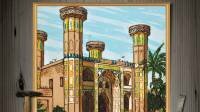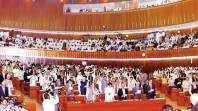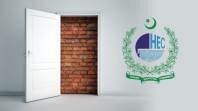Printmaking is an old technique of producing and reproducing high-value images. It has been used to reproduce the valuable work of masters and notable artists in order to create replicas of original paintings. Through an evolutionary process, the art of printmaking earned so much respect and value that it attained the title of a unique genre of visual arts.
This technique flourished in the East to a level that the West has had to look upon it for inspiration. The Japanese woodcut prints had made their mark so intensely that a Post-Impressionist great painter Vincent van Gogh (1853-1890) derived his colour palette out of them.
The soothing blue colour in art has been dominating in most styles of the Eastern art, whether it is Persian miniature, Rajput painting or Mughal art. This shade travelled to Europe with the Japanese woodcut prints to add new tinges to the oil painting mastery in the era when post-impressionists were experimenting with modern styles and ideologies.
Woodcut technique comes under the vast perimeter of graphic arts; commonly known as printmaking, along with etching, aquatint, dry point, lithography, and linocut. In Pakistan, as compared to painting, graphic arts or printmaking has made a very low count in terms of masters and great exponents of this genre.
We cannot name a true Pakistani graphic artist in any of the above-mentioned techniques with the exception of Gazanfar Ali and Nazish Atta Ullah. However, there is one name that we could present as the only harbinger in the field of Woodcut prints: Mahboob Ali, who has been experimenting in this genre since four decades.
Mahboob Ali started his career as a graphic designer as early as his student years at the NCA in the 1970s. It was a class assignment of printmaking that he had to accomplish, which became a landmark of his love and inclination towards the woodcut.
Since then, he has not looked back and has continued expressing his observations through this difficult and painstaking medium.
Mahboob Ali opened his eyes in the street culture of Lahore’s famed walled-city. He spent his childhood playing all the outdoor games and enjoying Lahori cuisine inside and outside the historical gates of Lahore. This factor imprinted the architectural and cultural patterns on Mahboob’s perception and when he found an opportunity for expression during college days, he went back to his origin for his discernible annotations. At the NCA, he learnt various techniques related to the visual arts. However, Woodcut became his passion, and then his sole obsession to the exclusion of everything else.
In his pursuit of giving tangible shape to his non-tangible observations, Mahboob Ali captured the matchless beauty of narrow streets of the Walled City. He imprinted the traditional, historical and colonial architectural patterns as well as the gates of Lahore, with unusual shades of printing inks.
He also experimented with challenging subjects such as the captivating ambiance of landscapes and intricate details of portraits. Mahboob Ali is probably the first graphic designer who has experimented with this relatively rudimentary genre of visual arts to bring about the aesthetic results which can only be associated with painting or drawing.
In a self-caricature, rendered in woodcut, he has applied the distortions that are linked with Fauves or Expressionists. In the same technique, he has tried to capture the effects of wind blowing across and bending the soft branches of a tree just like a landscape painter. In another landscape, Mahboob Ali, seems like a ‘Modern Realist’ when he very successfully confines the variations of light over flowing water and under the shades of a bridge – all in the difficult medium of woodcut. The salient feature of his cityscape-woodcuts is the depth and perspective that give the viewer’s eye the feeling and illusion of space so realistically that only a painter can attain with his range of oils or watercolours. The streets of the Old City of Lahore exhibit dabbed patches of light that falls down from above at a right angle. Mahboob’s observation for this particular light is so perfect and strong that during the multiple registrations of various colour plates, he never commits a mistake, and puts together a high chiaroscuro through several layers of diverse tones, carried by the woodcut blocks.
In recent years, Mahboob has experimented with various techniques, especially with his colour spectrum. He has created a woodcut print in 100 colours, which simply means that he has to use his woodcut blocks, one hundred times on the same paper for imprints with all the painstaking protocol required for a woodcut printing.
Mahboob Ali, as a professional practitioner, has been deeply indulged in his work and displayed a plethora of woodcut prints of unmatched quality. For over 40 years, he has delivered, in his own capacity, with no point of return since his college days. However, this is a very painful and thought-provoking reality that we could not find any of his real successors in this genre.
Owing to a demanding and conscientious technique that commercially does not repay the artist in an expected way, it is likely that no young talent will adopt this unique way of expression as an avant-garde branch of graphic arts. There is a need at the national level to promote this skillful art, lest we would only have it breathing in the impressions of the printing ink.
The writer teaches Art History at the Punjab University College of Art and Design, Lahore. He can be reached at [email protected]




























